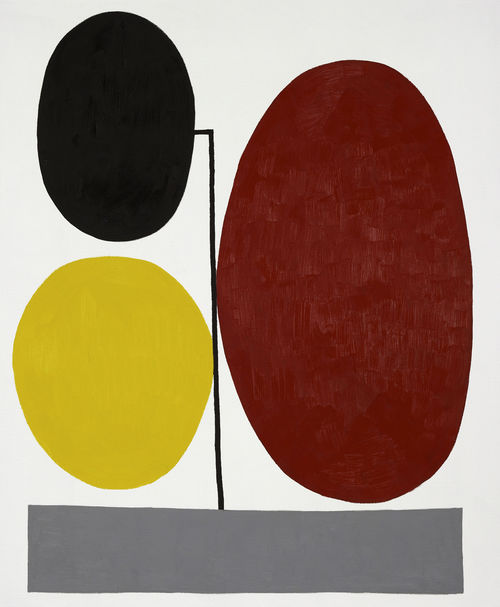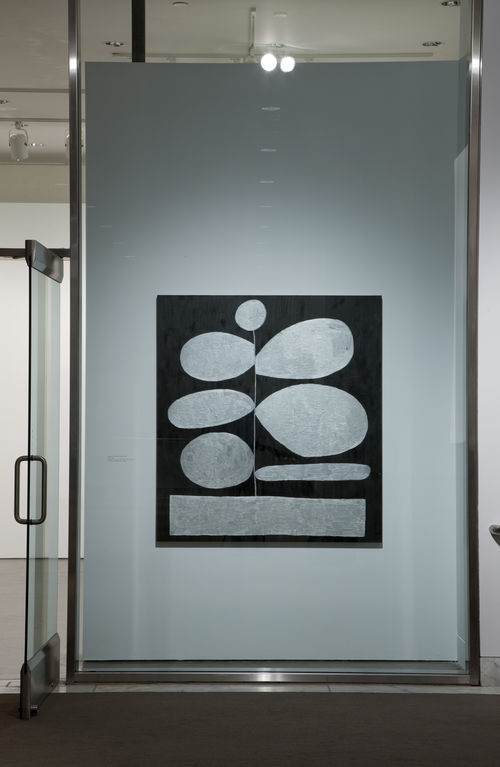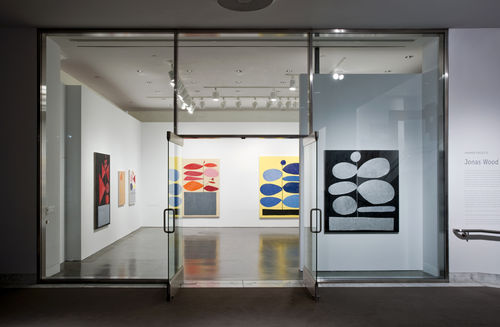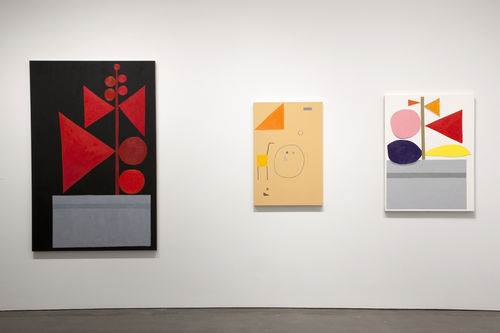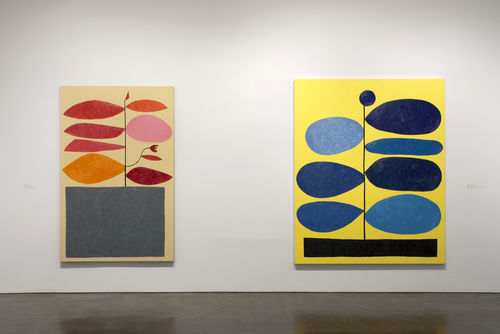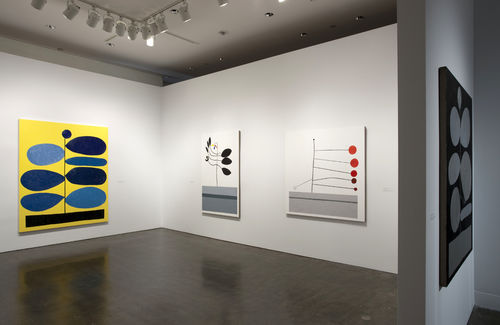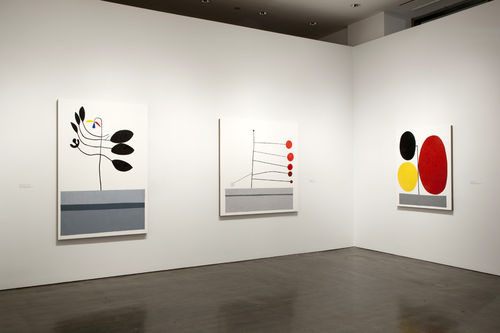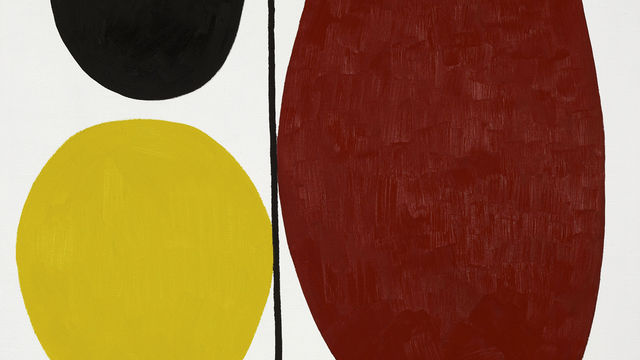
Hammer Projects: Jonas Wood
- – This is a past exhibition
Jonas Wood paints scenes of the world around him through the prism of his memory. Deploying genres as time-honored as the medium itself, Wood paints portraits, interiors, and still lifes. His immediate surroundings are his subjects: family and friends, domestic or studio spaces, tabletop arrangements of ceramic vessels and plants, and landscapes. Through his prolific practice, Wood is building a visual diary of sorts, an ever-expanding documentary of personal memories and interests. Usually painting from collaged photographs, Wood takes delightful liberties with background, scale, and color, often distorting figures, employing unusually vivid hues, or adding a work of art in place of a family photo in an interior scene.
For the past year, Wood has been painting a new series of still lifes which will be presented for the first time in this exhibition. Evolving out of his ongoing series of tabletop scenes of arrangements of potted plants and vases displaying cut flora, these new paintings each feature a rectilinear form with branching lines and geometric shapes reaching out and upward into the picture planes. Painted in bright colors and solid black against monochrome backgrounds, the forms recall Wood’s more realistically rendered potted plants as well as abstract sculptures atop plinths. Evocative of the Modernist sculptures of David Smith or Alexander Calder as well as Henri Matisse’s boldly-colored abstract collages, these more abstract works combine Wood’s interest in direct experience with his fascination with the many forms and genres found throughout art history.
Hammer Projects: Jonas Wood is Jonas Wood’s fist one-person museum exhibition and is organized by Corrina Peipon, Hammer curatorial associate.

Biography
Jonas Wood was born in 1977 in Boston, Massachusetts and lives in Los Angeles. He received a BA in psychology in 1999 from Hobart and William Smith Colleges and a MFA in painting and drawing from the University of Washington in 2002. Wood’s work has been the subject of one-person exhibitions at MinMin Gallery, Tokyo; Shane Campbell Gallery, Chicago; Anton Kern Gallery, New York; and Black Dragon Society, Los Angeles. His work has been included in thematic exhibitions including Copy, White Columns (2009), New York and Modern Lovers, Glendale College Art Gallery, Glendale, CA (2007) and will be part of Hard Targets, Wexner Center for the Arts, Columbus, OH (2010).
Essay
By Corrina Peipon
Jonas Wood paints scenes from the world around him through the prism of his memory. Using genres as time-honored as the medium itself, Wood paints portraits, interiors, still lifes, and landscapes. His immediate surroundings are his primary subjects: family and friends, domestic or studio spaces, tabletop arrangements of ceramic vessels and plants, a tangle of freeways, or a lush green golf course. Through these traditional means, Wood is building a visual diary of sorts, a subjective documentary. Many of his compositions are derived from collages of photographs he takes of his friends and family, of rooms in his childhood home or his studio, or of his own reflection in a mirror, among many other subjects. He often executes preliminary sketches or studies based on the initial collage, occasionally going further by removing part of a sketch and expanding upon it or adding it to yet another collage before committing the composition to canvas.
While it is always possible to read Wood’s paintings as being of something, his process produces imagery that veers toward abstraction by alternately or simultaneously flattening, elongating, or fragmenting spaces and forms, effects that he seamlessly translates into the paintings. His experiments with abstraction do not result in strictly nonobjective paintings, but the delightful liberties he takes with background, scale, and color, as well as his propensity to distort figures and juxtapose spaces, help move the compositions ever so slightly away from nature. By reducing pictorial specificity, Wood suggests that all representation is already abstraction. Nonetheless, his process of representation allows him to effectively express his subjective impressions of a given theme. As much as Wood is manipulating formal strategies in order to develop and assert his own language in painting, he also creates what he calls “new memories” by rearranging reality to suit his own desires.1 This overlay of impressions and memories onto his subjects results in an intensely personal catalog of images derived from his family history and individual interests. By inventing and committing to a formal language deployed throughout the paintings, Wood allows us access to these new memories of a private world.
Rather than being derived from a collage of several images, some of Wood’s paintings are based on a single photograph. In these instances, the subject and its surrounding context are often altered within the final composition. Robin with Phoebe (2008), for instance, began with a photograph of Wood’s mother taken when she was sixteen. Wood added Phoebe—a childhood pet—to the portrait, and he significantly expanded the space around her, adding lush flora that seems to extend infinitely in all directions. Similarly, portraits of Wood’s grandfather—Untitled (Rosy) (2006)—and his friend the artist Nick Lowe—Nick Lowe 2 (Peach Faced Love Bird) (2007)—feature almost identical fanciful backgrounds. Based on the pattern of the wallpaper in his grandfather’s kitchen, the exaggerated, brightly colored floral design gives a vaguely psychedelic feel to the images, adding to both the visual complexity and the psychological depth of the works. Alternatively, portraits of his father and of the artist Philip Guston are set on nearly monochromatic backgrounds. The pale pink field and patterned shirt in P. Guston (2006) pay homage to Guston's famously rose-hued palette. The same pink aura surrounds Wood’s father in JSW 1971 Passport (2008), while the figure is rendered in shades of gray. In Untitled (BW Self-Portrait) (2008), Wood replaced his mother with himself in front of the same outsize, verdant plant used for the background in Robin with Phoebe. As with the portrait of his father, the palette of the self-portrait is in a gray scale. Shirtless and with chin up, Wood appears confident, almost defiant, but the camouflage pattern on his pants also suggests reticence.
While the spaces occupied by the subjects in Wood’s portraits are abstracted to varying degrees, the environs in his interiors and still lifes are rendered more realistically. Still they engage the same distortions that activate the portraits. In particular, his denial of perspective presents each scene on a nearly flat picture plane. The vertical orientation in the composition engenders a physical identification with the paintings that is enhanced by their scale. When small, the canvases exude energy and seem as if they might tumble forward. When large, this strategy provokes an experience akin to viewing sculpture: the works become confrontational and enveloping, surpassing their role as imagery through scale. Wood’s interiors are almost always unpopulated. Furniture and rugs are opportunities for him to explore pattern, form, and color, while artworks hung about the walls pose questions about image making, meaning making, and the formation of memory.
Untitled (Self-Portrait) (2009) is one of an ongoing series of self-portraits based on photographs Wood takes of his reflection in a mirror. Wearing a gray hooded sweatshirt and a green knit cap, he faces his reflection squarely in the center of the composition. Behind him, small pictures are hung on the wall in a casual way. Represented by contiguous small fields of color, these quasi-abstract forms might be photographs, postcards, or images cut from magazines or newspapers. One of them appears to be a child’s drawing of a jumble of shapes, including a rudimentary rendering of a horse. These images within the image function like miniature experiments in abstraction within the portrait.
The child’s drawing that appears in Untitled (Self-Portrait) is based on one made by Wood’s older sister, Alexis. Wood re-created the handful of shapes strewn across the flat ocher ground of Alexis’s drawing at an enlarged scale for Untitled (Background Drawing) (2009). Alongside the hundreds of portraits, still lifes, and landscapes that make up his oeuvre so far, this painting at first seems anomalous. It is fascinating not merely because of its singular strangeness but also because of its improbably appealing palette and refreshingly odd composition. Its simple shapes recall the recognizable forms of a horse and a human face without relying on their complete articulation. Doubly removed from its context, Untitled (Background Drawing) is both an abstract composition of shapes and colors and a representational painting of Wood’s sister’s childhood drawing.
Plants feature prominently in Wood’s interiors and still lifes. Potted plants and cut flora provide ballast to the compositions while adding liveliness and color. Terra-cotta pots; ceramic vessels made by Wood’s wife, Shio Kusaka; and ancient Greek vases sketched during his frequent visits to New York’s Metropolitan Museum of Art appear in paintings with bright green foliage sprouting from their mouths. Begun in 2009, the series on view on this exhibition—informally titled New Plants—is perhaps most obviously related to Wood’s still lifes, yet these more abstract compositions also have a kinship with the paintings within paintings that turn up in his interiors. These small-scale background elements—which pay homage to the history of painting as well as to Wood’s personal history (both of his maternal grandparents were hobbyist painters and collected works by Francis Bacon, Roy Lichtenstein, Robert Motherwell, and Robert Rauschenberg, among other artists)—are writ large in New Plants.
Each of the New Plants paintings features a rectilinear form at the bottom of the canvas from which branching lines and geometric shapes reach upward and out. Rendered in vivid palettes against monochromatic backgrounds, the forms resemble both Wood’s depictions of potted plants and abstract sculptures atop plinths. Alexander Calder’s lively geometric sculptures directly influenced Wood during the inception of the series. Though three-dimensional, Calder’s work has an alluring, somewhat ironic flatness that allows the sculptures to appear like free-floating drawings in space. Like Wood, Calder resisted perspective in many of his works, creating the illusion of flatness in three dimensions. Wood’s use of color, compositional arrangements, and subject matter bring to mind Henri Matisse’s genre paintings. In New Plants, Matisse’s influence is also evident in Wood’s use of fields of color to describe forms, a technique akin to some of the French artist’s later paintings as well as his boldly colored gouache-on-paper collages. The strategy is also reminiscent of Milton Avery’s quiet genre scenes, which are characterized by simplified forms articulated through eccentrically colored shapes and lines that are just as often etched into the layers of paint as they are drawn. For Wood, as for Avery, brushwork is an integral part of the visual experience of his paintings. The visible evidence of the short, straight brushstrokes adds heft to the forms while avoiding modeling. This method reinforces the flatness of both the painting’s surface and the picture plane. Like enlarged versions of his paintings within paintings, the more abstract works in New Plants combine Wood’s interest in painting from direct experience with his fascination with the many forms and genres found throughout art history, deepening and extending his investigation of the language of painting.
Notes
1. Jonas Wood, conversation with the author, January 13, 2010.
Hammer Projects is made possible with major gifts from Susan Bay Nimoy and Leonard Nimoy and The Horace W. Goldsmith Foundation.
Additional generous support is provided by the Los Angeles County Arts Commission, Good Works Foundation and Laura Donnelley, L A Art House Foundation, the Department of Cultural Affairs, City of Los Angeles, and the David Teiger Curatorial Travel Fund.
Hammer Projects: Jonas Wood has also received support from John Rubeli.



